
The Via Consolare Project in Pompeii
 |
||||||||
|
The Via Consolare Project in Pompeii
| ||||||||
| Home | Research | Internships | Team | Links | Contact | |||
| Summary | 2005/2006 | 2007 | 2008 | 2009 | 2010 | 2011 | 2012 | 2013 | 2014 | 2015 | 2016 | 2017 | 2018 | VCP 3D |
| 2019 |
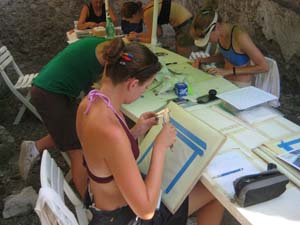
Pottery drawing underway 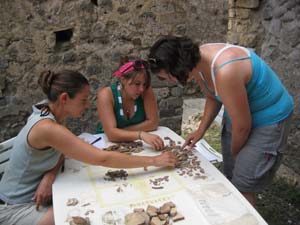
Pottery sorting |
Field Season 2010 Though long-forgotten to scholarly research, Insula VII 6 and the area of the Villa delle Colonne a mosaico are of vital importance in the history of Pompeii, and are likely to contain a number of clues to the socio-political and economic motivations behind the changing urban environment within the ancient city from its foundation until the eruption of Vesuvius. Our excavations have now begun to yield significant new information on the motivations and nature of these changes – a story that has only become clearer this year with continued work on the artefacts and ecofacts recovered. Between the 16th of June and the 4th of August 2010, with the kind permission the Ministero per i Beni e le Attività Culturali, Soprintendenza Speciale per i Beni Archeologici di Napoli e Pompei, and with the kind support of Prof.ssa. Salvatore, Prof. Proietti and Dott. Varone, the members of the Via Consolare Project continued our ongoing research in these areas. The purpose of this summer’s field season was to prepare and finalise the results of the previous two seasons of excavation in preparation for forthcoming publication. To this end, the materials recovered during the summers of 2008 and 2009 were examined, recorded, and analysed. Specialists in pottery, numismatics, animal bone, charcoal, and the study of ecofacts, examined the data that our excavations of the last two seasons had produced. As a result of these efforts, the majority of all finds have now been studied. All soil samples floated in previous years have now been thoroughly sorted and accessioned. In addition, all animal bone recovered has been washed and preliminary sorting of taxa has begun. The precise of identification of charcoal remains has commenced. All pottery recovered has now been processed for the provision of ceramic-based date ranges, which have continued to be refined and finalized during the rest of the year. Records of all coins recovered have been made and the stratigraphic sequence discernable in the standing remains has been finalised pending further excavation. In short, there is no backlog of substantial post-processing of data to be completed. This is especially important because the Via Consolare Project is, in particular, committed to making our results available to the community of Pompeian scholars and the Soprintendenza archeologica di Pompei with at little time as possible between excavation and publication. It is therefore vital that the processes of finds analysis and publication go hand in hand with on-going excavation. The successful completion of our target goals for finds analysis and post-processing this year means that our publications are well on track to maintaining this commitment. |
|
Completion of Ecofacts Sorting and Recovery, Specialist Analysis
This year the Via Consolare Project brought together an international team of materials specialists to begin analysis of the materials excavated in the 2008 and 2009 seasons. Environmental samples During excavation in 2008 and 2009, eight-litre soil samples were routinely taken from each excavated ancient deposit for flotation. The floating of that material was completed in 2009, but 19 of these samples were left to be sorted in 2010. During the first two weeks of the season, the Project devoted much of its time to the completion of the sorting and identification of macrofaunal and floral remains from these samples. The Project visually identified animal and fish bone, fish scale, sea urchin, land and sea snail, charcoal, and carbonized seeds, as well as a number of non-environmental artefacts. Charcoal and Micro-Faunal Remains Dr. Robyn Veal, an expert in the study of ancient charcoal remains, was able to complete an inventory of samples of contextual carbonized wood remains recovered during excavation. Working in conjunction with Dr. Veal, Charlene Murphy (BA, MA), a specialist in the recovery, analysis, and categorization of ancient microfloral remains, also made a preliminary inventory of the materials recovered through flotation from our contexts and began analyzing the carbonized seed and other microfloral materials. She will continue to work with Dr. Veal in the analysis of the flotation materials during the year. Animal Bone During the 2010 season, Rachel Hesse (BA, MA), a specialist in the recovery, analysis, and categorization of ancient microfaunal remains and zoological analysis completed sorting approximately 50% of the recovered animal bone into diagnostic and non-diagnostic fragments, as well as taxa, including equine, bovine, swine, goat/sheep, and fish. A preliminary examination revealed a strong trend within our excavated areas, indicating high percentages of ‘off-cuts’ of butchery activity – cranial fragments, limbs, jaws, smaller vertebrae, and tarsi – precisely the sort of ‘low-class’ butchery remains that might be expected in Pompeian corner-shops, clearly even those located right next to the Forum. Further analysis will help to determine more about the faunal taxa and activities in the area of our excavations. Numismatics Dr. Richard Hobbs, Curator of the Romano-British Collections for the British Museum in London, and an expert in the study of Roman metalwork and numismatics, was able to access and study the coins produced through excavation in 2008 and 2009. Dr. Hobbs was successful in completing a complete inventory of the coins and creating impressions of each in clay with which he will produce casts for further study and analysis in London. Preliminary examination suggested that the assemblage is particularly representative of local and early minting processes of the Republican period in the city, with only a single coin of Nero dated to AD 77. This last date provides an important terminus post quem for the extensive final-phase rebuilding activities documented in the south east corner of Insula VII 6 last year. It is therefore possible to suggest a relatively long period between these building activities and the earthquake(s) of AD 62, which in turn implies either that the two events were unrelated, or that clearly important municipal-scale activities were delayed by roughly 15 years, perhaps due to the extensive scope of on-going seismic damage. |

Sorting the final flot samples 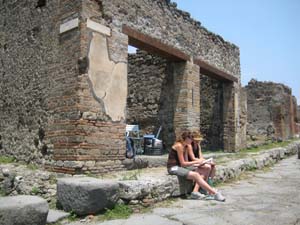
Consulting outside of the 'Lupanar' 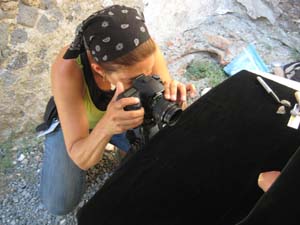
Photography of small finds |

Inked pottery illustrations from 2010 - AA001. 
Working Phasing Summary of Insula VII 6 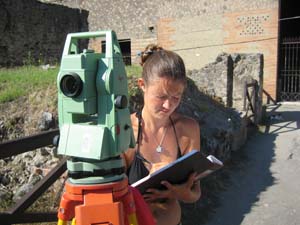
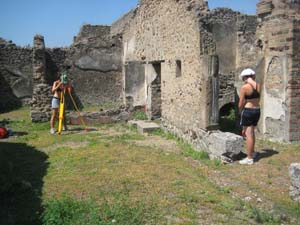
Surveying in Insula VII 6 |
Sorting of Pottery/Drawing of Pottery
During this season, the team also continued to process and study the ceramic artefacts recovered during the summers of 2008 and 2009. The team sorted 8.5 kilograms of pottery from deposits left over from work undertaken during the 2009 season. After all of the pottery had been sorted by category, the team examined the pottery by phase in order to reveal overall trends and discrepancies. This process also produced the initial spot dates for our areas. A more detailed and definitive study will produce firm dates for these contexts following on-going research throughout the year. In order to assist this process while away from Pompeii, the team completed a thorough record by drawing each diagnostic sherd in a technical illustration. A database with entries on colour, weight, rim diameter, and fabric hardness for each diagnostic sherd was also made. Fabric classes were developed in the field but further research will be necessary to finalize the wares sequence. Wall Analysis In an effort to pair the understanding of the subsurface findings from the excavations of the VCP in 2008 and 2009 and the standing remains of the Insula VII 6, a major component of the 2010 season was the architectural phasing of the insula. In previous seasons, we performed detailed wall analyses to discern and record the various construction types, materials, and mortar compositions used throughout the block, focusing on areas of particular relevance to our Archaeological Areas of 2008-2009. Building upon this previously collected data, this season the team produced a comprehensive phasing of the walls on an insula-wide scale, synthesising a diachronic narrative of the building phases in VII.6. The construction narrative revealed by this work provides a new look at several important aspects of urban development in Pompeii: the evolution of architectural forms defining houses and shops, the transition from residential to commercial spaces, and the probable requisition of private property for the civic activity of water management and distribution. Particularly important in this narrative is the southeast corner of Insula VII 6, which reveals the comparatively late build-up of the urban landscape, even just steps from the Forum. Later, the same area witnesses use for private housing and commercial undertakings – in some cases truncated by municipal level construction – including a second phase of post-earthquake construction work. This area will therefore be detailed in full, in our forthcoming publication. Survey During the field season of 2010, the Via Consolare Project continued to undertake topographic survey with the primary goal of completion of a 3D wire-frame model of Insula VII 6 and the area of the Villa delle Colonne a mosaico. In conjunction with these aims, team members instructed interns in the theory and method of 3D topographic survey and accompanying technological applications. Our Leica TCR805power Total Station continued to be used in combination with a Leica GMP111-0 Mini Prism to conduct the survey. In addition, survey made use of an in-house point download format file in order to string our points together automatically, greatly speeding the process of producing an accurate wire-frame model. After re-establishing the grid of known temporary bench mark (TBM) points around Insula VII 6 and up to the Villa delle Colonne a mosaico, efforts were focused on extending the model to the north to incorporate the shops along the eastern side of the Via dei Sepolchri, as well as completing a few areas of VII 6 that had not previously been surveyed. As a result, the Project’s 3D dxf model now contains accurate data for the Via Consolare frontages of the Villa and shops including doorways 12 through 21, the viridarium of the Villa, and for the vast majority of Insula VII 6. This model will further serve as the base into which our new method of 3D photogrammetric recording (cf. infra) will be incorporated, both to provide accurate scaling for the method, and to coordinate the data into a single 3D model of our research areas. It will therefore serve to provide a permanent and detailed record of the current condition of all standing remains and any subsurface structures and deposits recovered during present or future excavation. Further, the survey data collected is used by the Project to test and develop theories regarding the use, layout, evolution, and final-phase appearance of our study areas, as well as providing the contact point for coordinating results from our other processes of examination: excavation, wall analysis, and photogrammetry. |
|
Low-Cost 3D Photogrammetry Continuing the Project’s commitment to the use of freely available cutting-edge computer technologies in archaeology, during the summer of 2010 we integrated a cutting-edge method of 3D data acquisition into our research methodology. Using unordered sets of digital photographs taken with consumer-grade digital cameras this highly-accurate system produces millions of 3D points of target objects, each with all the point, colour, and surface normal information necessary for complete 3D surface reconstruction. When paired with accurate total station survey of these remains, the end result is a scaled and accurate model of the archaeological remains, down to individual stones. This summer, we have applied this new method to recording the walls of Insula VI, 1, 2-4 as a preliminary test of its capabilities and as a part of the VCP’s efforts to assist Dr. Hilary Cool in brining the data produced in the University of Bradford’s excavations in this area to final publication. Preliminary assessment of our results indicates that this method of wall recording will speed their process of publication significantly. Furthermore, informal comparison of our results with recent time-of-flight laser scan data produced in the Forum by Profs. Balzani, Santo Puoli, Grieco, and Zaltron of the Universitià di Ferrara and in the Casa della Diana (VII 6, 3) by Prof. Luzòn of the Universidad Complutese de Madrid, suggests that our results are an equally useful record of the standing remains, permitting a complete 3D reconstruction of the existing walls and floor features. Conclusions The important data preserved in Insula VII 6 and the Villa delle Colonne a mosaico have suffered not only due to long exposure and bombing, but also from a general lack of scholarly awareness of their existence, paired with the general belief that little remains to be studied in these areas. Our work has proven that these areas are not only archaeologically rich, but of vital importance in understanding the development of the city. Our continued research during the summer of 2010, and in particular the formalisation of our understanding of the developmental sequence of Insula VII 6 has also raised a number of important new questions and highlighted areas that must be investigated further in future field seasons through further walls analysis, cleaning and recording of AD 79 remains and continued small-scale excavation. We remain deeply indebted to the Soprintendenza Archeologica di Pompei, Prof.ssa. Salvatore, Prof. Proietti, and Dott. Varone, and extend our greatest thanks for their kind and continued support and encouragement in our research activities. |


Survey Wireframe for Insula VII 6 as of 2010 
3D surface model of a wall within Insula VI 1 |
 |
|
|
||||||||
|
Website Content © Copyright Via Consolare Project 2018
| ||||||||